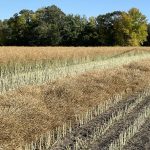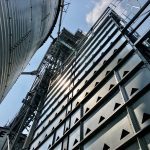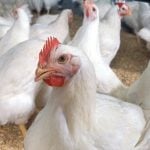Deodorizers, enzyme additives, plastic covers or chopped straw haven’t been able to take the stink out of pig manure.
Now a Saskatoon research scientist says his company has come up with an effective and affordable way to deal with a problem that continues to bedevil the rapidly expanding hog industry.
“This goes right to the root cause of the odors,” said Gurunathan Lakshman, president of System Ecotechnologies Inc. of Saskatoon.
The company’s technology removes chemicals that create the foul aromas before the manure goes to the storage lagoon.
Read Also

Trade war may create Canadian economic opportunities
Canada’s current tariff woes could open chances for long-term economic growth and a stronger Canadian economy, consultant says — It’s happened before.
Operating out of a modest office and laboratory in Saskatoon’s Innovation Place research park, SEI said it’s a few months away from marketing a system that makes the smell bearable and turns the manure in recyclable water and sludge.
He said the new system will cost producers less than they’re now paying for traditional lagoon-based manure handling systems.
Research indicates that an average 600-sow hog operation spends about $3.60 per marketed pig on manure handling, and doesn’t get rid of the smell.
The SEI system costs about $3 per pig marketed, and Lakshman expects that can be reduced to $1.80 to $2.50 per pig as technology improves.
And that doesn’t include the financial benefits the producer can realize from the recycled water, ammonia and nutrient-rich sludge.
The capital costs of the SEI system won’t be known until a pilot-scale project is set up later this fall. If all goes according to plan, the technology will become commercially available in February 2001, according to Lakshman.
The pilot scale plant will be funded in part by the Manitoba Livestock Manure Management Initiative. The company is also looking for assistance from industry groups in Saskatchewan and Alberta.
The Manitoba organization has previously provided $40,000 towards the original technology development and $15,000 for economic analysis. Saskatchewan Agriculture chipped in $30,000 for technology improvement. SEI and a partner chemical company have more than matched that investment to date.
Factors to consider
Lakshman, who worked at the Saskatchewan Research Council before setting up SEI in 1986, said in an interview he had five key principles in mind as he designed the new system: the system should be low-technology, it should be effective, it should be affordable, it should be simple to operate and, if possible, it should provide beneficial by-products.
He said the company always tried to keep in mind the many demands on producers’ time.
“We didn’t want to give the farmer a long checklist of things to do at eight o’clock every day,” he said. “He has other things to do.”
Lakshman said his original proposal to Manitoba’s manure management initiative two years ago reflected the idea that none of the existing methods of dealing with hog waste was actually aimed at treating the manure. Rather, they were based on covering it up or adding something to mask the aroma.
The foul odors are the result of anaerobic bacterial degradation of sulfur-containing organic compounds, producing ammonia, hydrogen sulphide and particularly odiferous compounds known as mercaptans, which are added to natural gas to produce a warning odor.
In a nutshell
Here’s how the SEI system works:
- The manure is pumped from the barn to the first of two holding tanks.
- Two chemicals are added, creating reactions that separate the solids from the liquid, eliminate the odors, concentrate most of the nutrients in the solids, capture the ammonia and produce a relatively clear, odorless, re-usable water.
- The water is discharged to the storage lagoon where it can be stored without producing objectionable smells. The level of nutrient in the water can be adjusted to suit individual operations.
- The water can be recycled as barn wash, which suppresses odors from the manure pits, or used for crop irrigation.
- Solids are augered from the first tank and turned into a sulfur rich sludge, which can be applied as fertilizer to canola, mustard and alfalfa crops, or converted to fuel pellets.
- The ammonia is recovered and can be used as fertilizer.
The manure is in the system for less than three hours. A 600-sow operation would require a space of roughly 500 sq. feet with a clearance of about 10 feet, adjacent to the hog barn.
The chemicals are inorganic and non-toxic and available throughout North America. However Lakshman declined to identify them, since the process is to be patented.
SEI plans to commercialize the system in partnership with a Saskat-chewan-based chemical company. The system would be individually designed for each farm and be monitored free of charge for six months.














